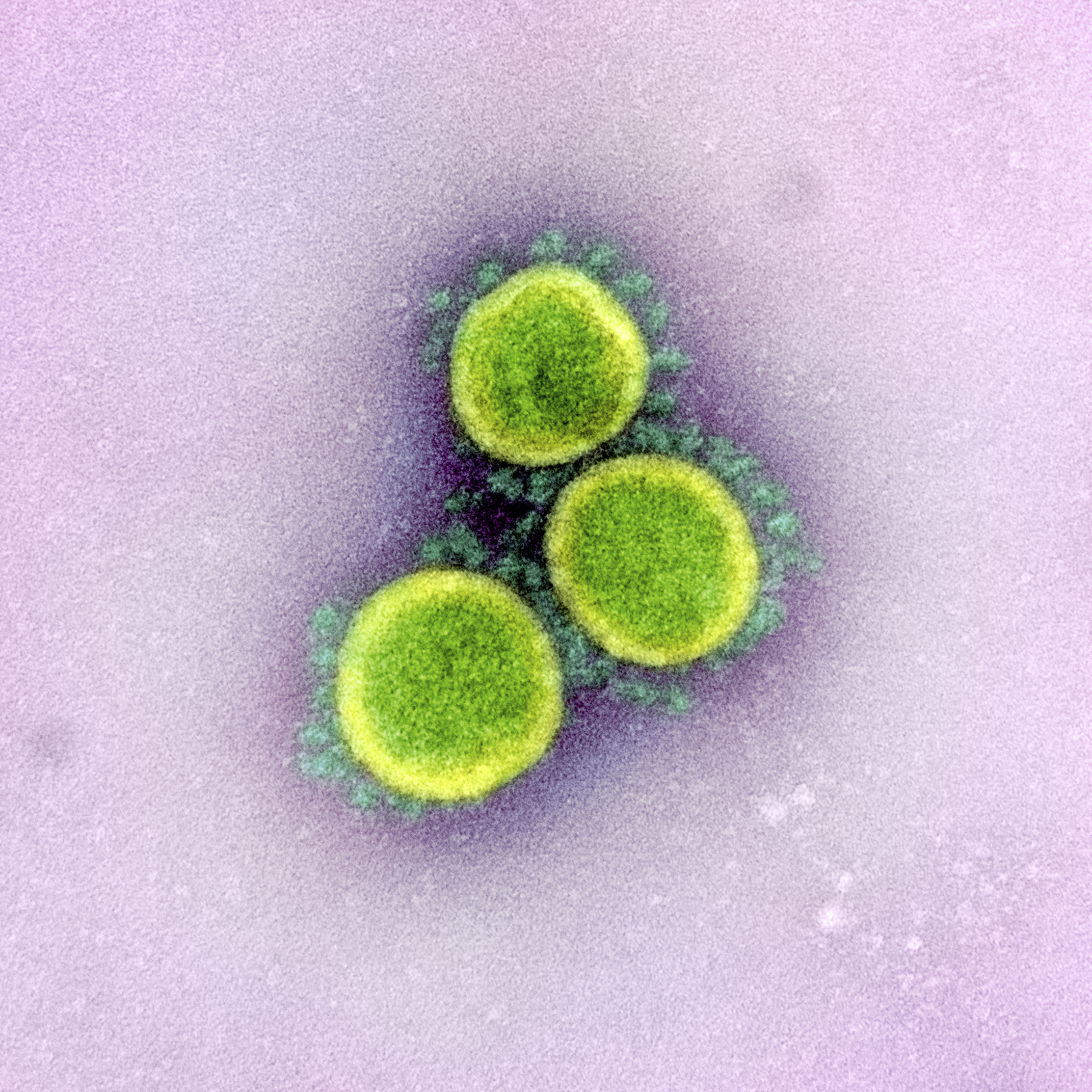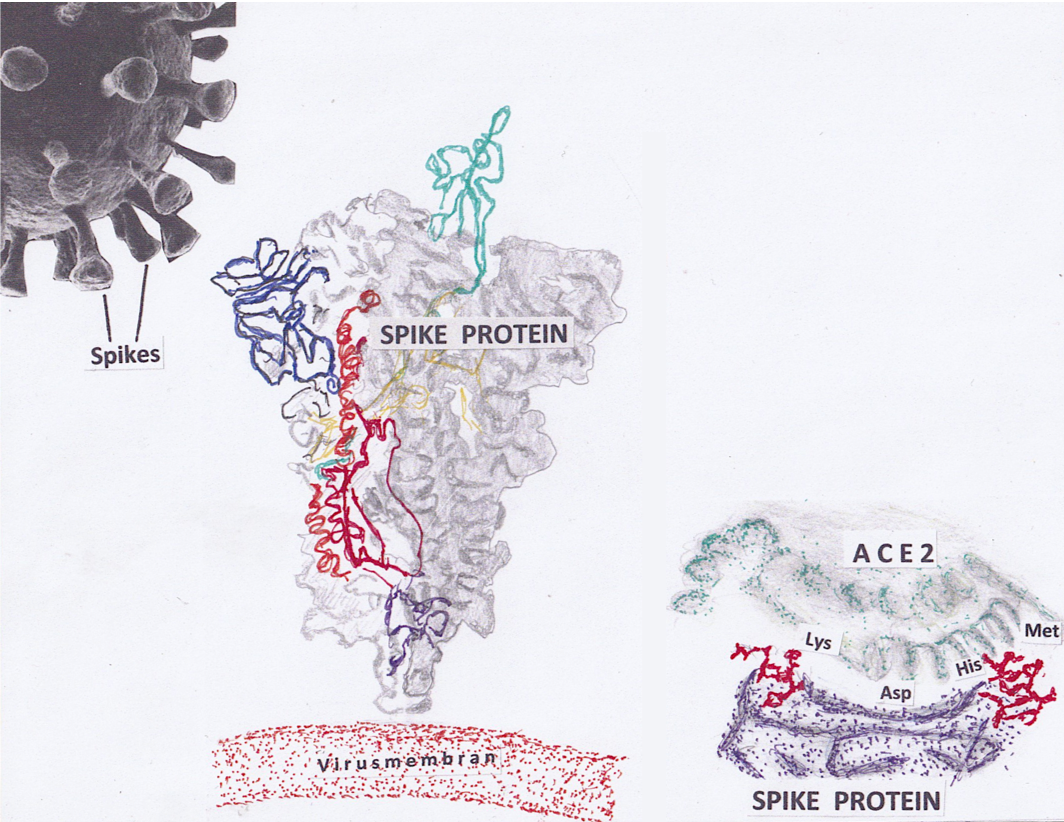Trenzyme GmbH
The SARS-CoV spike protein and its receptor
The SARS-CoV-2 coronavirus uses a spike protein to bind to the ACE2 receptor on the cell surfaces of lung tissue. Additional cofactors are needed to allow the virus genome to penetrate human cells and multiply. Knowing these relationships can help understand the course of the infection and develop counterstrategies. To this end, the Constance-based company Trenzyme has produced a recombinant spike protein to support coronavirus research.
In December 2019, information about the occurrence of a new type of lung disease in the central Chinese city of Wuhan was initially rigorously suppressed and censored by the Chinese authorities before the World Health Organisation (WHO) was eventually informed on December 31, 2019 of the existence of several cases of viral pneumonia with unknown causes. Just one week later, Chinese scientists submitted a paper to the renowned scientific journal “Nature” (published online on 3rd February 2020) describing, based on genome analysis, a novel coronavirus associated with lung disease. This coronavirus was later named SARS-CoV-2 and has since spread worldwide, causing the devastating COVID-19 pandemic.
Disinformation and free communication of scientific information
 The coronavirus SARS-CoV-2, electron microscope image (recoloured). License: CC-O (public domain; ID: 2294135), original source: US Government departement, the National Institute of Allergy and Infection Diseases
The coronavirus SARS-CoV-2, electron microscope image (recoloured). License: CC-O (public domain; ID: 2294135), original source: US Government departement, the National Institute of Allergy and Infection DiseasesThe scientists who published the paper in Nature isolated the virus from a patient who fell ill on December 20, 2019 and was hospitalised a week later. The patient worked at a seafood market in Wuhan, where live wild animals were also sold and slaughtered on-site. Comparative genome analyses led the researchers to conclude that SARS-CoV-2 (similar to its predecessor, the 2003 SARS coronavirus) originated in bats and was transmitted to humans via an intermediate host - possibly a pangolin - that is traded at the Wuhan market. The seafood market was closed on January 1, 2020, and shortly after, the central government in Beijing banned all trade in wildlife at Chinese markets. Subsequently, in mid-March 2020, official spokespeople from the very same government began peddling conspiracy theories, claiming that the United States had introduced the virus into China. At that point, the first major wave of infections was under control in central China, thanks to "the most ambitious, agile and aggressive disease containment efforts in history" (according to the WHO-China Joint Mission report on Coronavirus Disease 2019, published in March 2020) and China's lifelong head of state, Xi Jinping, was acclaimed for his victory over coronavirus and held up as a role model for other countries afflicted by the pandemic.
Given the context, the speed at which the Chinese scientists made the complete RNA sequence of SARS-CoV-2 available is laudable. Based on their results, laboratories such as Professor Dr. Christian Drosten’s at the Charité Institute of Virology in Berlin have been able to rapidly develop and validate an RT-PCR (reverse transcriptase polymerase chain reaction) test, enabling the highly accurate detection of the virus. This test is now being used around the world. The molecular data published by the Chinese can also be used to specifically search for effective vaccines and medications to combat the COVID-19 pandemic, with such developments now being pursued at full speed.
The coronavirus spikes
 Spikes and spike protein of SARS-CoV-2. Left: Cryoelectron microscopy structure of the spike protein conformation prior to its fusion with the human cell membrane. Individual protein domains are coloured; the receptor binding domain (RBD) is shown in green. Bottom right: coupling between the RBD of the spike protein and the binding sites of the ACE-2 receptor; the sugar chains of the spike protein (red) come into contact with the receptor due to a change in conformation. Source: Drawings by EJ modified from Wrapp et al. (2020)
Spikes and spike protein of SARS-CoV-2. Left: Cryoelectron microscopy structure of the spike protein conformation prior to its fusion with the human cell membrane. Individual protein domains are coloured; the receptor binding domain (RBD) is shown in green. Bottom right: coupling between the RBD of the spike protein and the binding sites of the ACE-2 receptor; the sugar chains of the spike protein (red) come into contact with the receptor due to a change in conformation. Source: Drawings by EJ modified from Wrapp et al. (2020)SARS-CoV-2 and related coronaviruses are characterised by spiked projections (“spikes”) on their surface, which give them their - now world-famous - appearance that resembles the corona during a total solar eclipse. The spikes consist of a glycoprotein that the virus uses to bind to a host cell receptor. Scientists led by Jason McLellan at the University of Texas in the United States have used electron microscopy at ultra-low temperatures to show that the spike protein changes conformation when it binds to the human cell receptor and the viral envelope fuses with the human cell membrane, allowing the virus genome to enter the human cell and multiply. The spike protein is therefore the focus of research in the development of vaccines and the search for effective drugs against a coronavirus infection.
Studies by Christian Drosten at the Charité in Berlin and others have shown that the spike protein of SARS coronaviruses binds to a receptor called ACE2 (angiotensin-converting enzyme 2), an enzyme that is found in high density on the cell surfaces of the lung tissue. McLellan and co-workers performed comparative structural analyses and binding studies of the spike proteins of different coronaviruses and demonstrated that SARS-CoV-2 has a binding affinity for ACE2 that is ten times higher than that of the previous SARS-CoV-1 in 2003. Antibodies that bind to the SARS-CoV-1 spike protein showed no affinity to the SARS-CoV-2 spike protein. The strong binding to ACE2 is also associated with the observation that some patients can become seriously ill following a COVID-19 infection or die of acute lung failure. The physiological function of ACE2 is to break down the angiotensin I hormone that increases the blood pressure. When SARS-CoV-2 binds to ACE2 by way of its spike protein, the hormone cannot be broken down, leading to an excess of angiotensin II. This might be the reason why patients with cardiovascular diseases, diabetes and high blood pressure in particular often become seriously ill due to COVID-19. Large numbers of ACE2 receptors also occur on intestinal epithelial cells. However, it has not yet been clarified whether these cells also represent a gateway for infection with the virus.
In addition to the ACE2 receptor, the virus also needs the cofactor TMPRSS2, an enzyme that forms a complex with the ACE2 receptor, to be able to penetrate the cell. Researchers already showed for the 2003 SARS virus that the activation of the spike protein by TMPRSS2 enabled the viral envelope to fuse with the cell membrane. In research carried out under the aegis of the German Center for Lung Research, Professor Roland Eils (formerly at the University of Heidelberg, now at the Berlin Institute of Health) along with colleagues from the Thoraxklinik at Heidelberg University Hospital and the Berlin Charité used single-cell sequencing to demonstrate on 60,000 individual cells that it is certain progenitor cells in the bronchi in particular that express the ACE2 receptor and the TMPRSS2 cofactor.
These progenitor cells usually develop into ciliated epithelial cells, which transport mucus and bacteria out of the lungs. The scientists observed that the density of ACE2 receptors on the cells increased with age and was higher in men than in women. This might have something to do with the fact that COVID-19 is more common in elderly people and generally more common in men. However, as Eils emphasizes, “our examinations only revealed a tendency, and our case numbers are too low for verifiable statements.” The studies show, however, that SARS-CoV-2 depends on certain body cells for multiplication and spread. Analyses of the relationships between the virus with its spike protein and human cells with receptors and cofactors help to understand the course of the disease in COVID-19 patients and to identify high-risk patients.
A recombinant SARS-CoV-2 spike protein
Trenzyme GmbH in Constance, Germany, has produced a recombinant protein containing the receptor binding domain (RBD) of the spike protein of SARS-CoV-2 to use in research into the coronavirus and how it binds to human cells; the C-terminus of the spike protein is labelled with a histidine tag. This recombinant protein, which can be used, for example, to develop vaccines, and as antigen or control protein for analytical or diagnostic tests, is also based on the genome sequence of the Wuhan virus that was deciphered and published in January 2020. Trenzyme was founded twenty years ago by the Constance biochemist Dr. Reinhold Horlacher, and has made a name for itself as a contract research company for the pharmaceutical industry and academic research. The company produces and purifies recombinant proteins in cell lines that express proteins particularly well. All work carried out by Trenzyme conforms to the strictest quality criteria. The recombinant protein with the RBD of the spike protein of SARS-CoV-2 has the potential to be used to find substances that can block the receptor and the entry of the virus into the cell, and hence develop strategies for effective therapies. Horlacher writes that, as CEO, he is proud that Trenzyme's products can also help drive forward the development of innovative drugs to contain and overcome the COVID-19 pandemic.